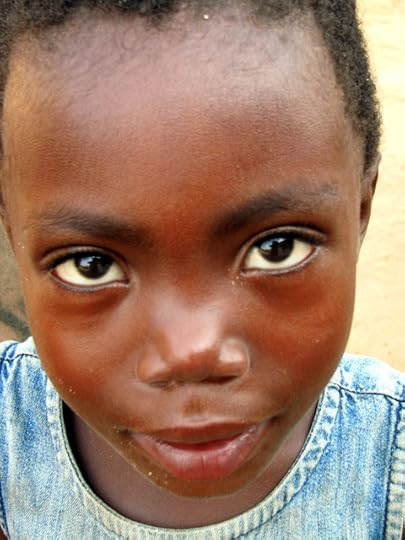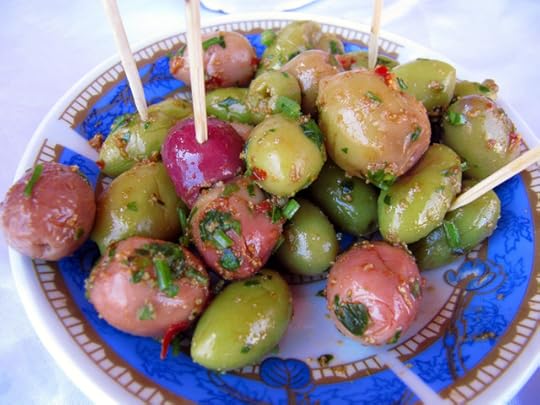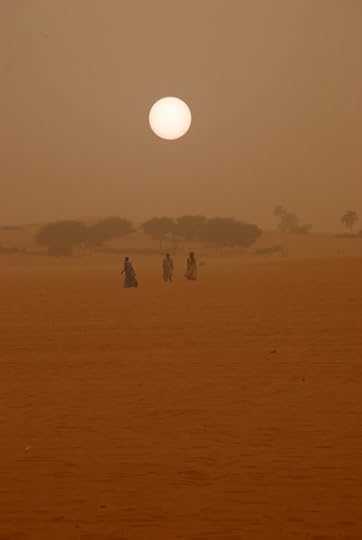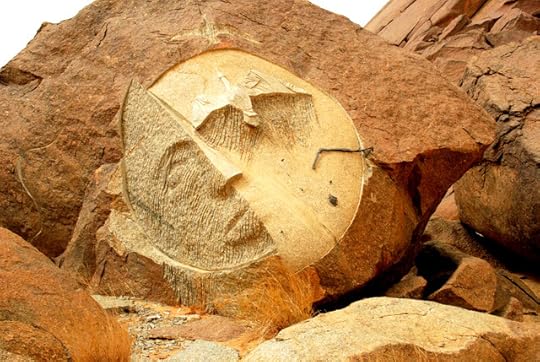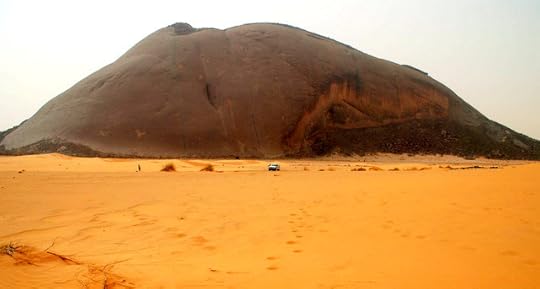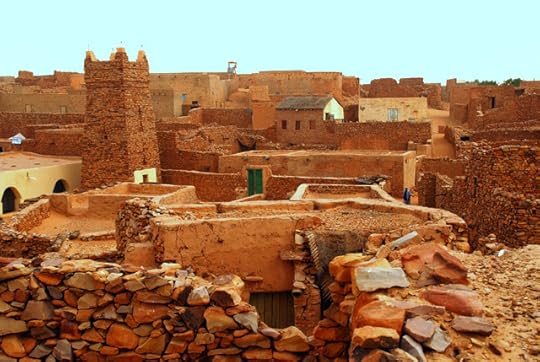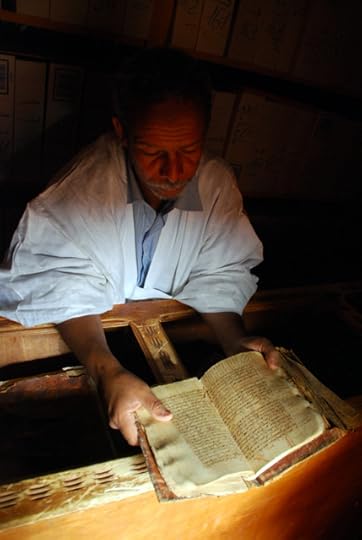Roderick Phillips's Blog, page 13
March 26, 2014
West Africa redux, Day 240
Oh dear. Christi is not feeling at all well. She has rebellious intestines that kept her up most of the night. She swears it wasn’t the tajine or olives or dates she ate yesterday, blaming it instead on a dodgy piece of fish she ate in Choum 3 days ago. That’s one hell of an incubation period. Either way, she has lost her desire for exotic foods, which is a shame because Christi was looking forward to the culinary temptations Morocco had to offer. Equally, we have to decide whether to risk a long bus journey or stay another day or two in Dakhla. Faced with that option, Christi swallows an Immodium and says let’s get the hell out of here.
We leave Dakhla mid-morning for the 9-hour ride to Laayoune, the largest town in Western Sahara, which lies close to the border with Morocco proper. Long bus journeys give you plenty of time to think and reflect and in my case to try to appreciate the 2 months we spent in West Africa (technically Mauritania, Western Sahara, and Morocco are part of the Maghreb, or Northwest Africa. The Maghreb marks a switch from Black Africa to Arab Africa). Perhaps the most appealing aspect of out time in Ghana, Burkina Faso, Mali, Senegal, and to a lesser extent The Gambia is the richness of its culture and its ethnic groupings, more than the presence of iconic tourist attractions. The traveling was certainly tough, but the rewards far outweighed the inconveniences (I can say that now!). I’m not sure Christi would agree that we left all our troubles in West Africa, however, as her stomach continues to be unruly – and unlike the wonderful buses of Argentina, our current CTM bus service lacks a toilet or a food service. The lack of food is not really a concern for Christi, but we are keeping our fingers crossed that there are no emergencies.
With all these distractions, Christi and I failed to immediately notice that a large number of uniformed police also boarded the bus in Dakhla together with several swarthy looking characters. They sit at the back of the bus and keep themselves to themselves. Another layer of security we have to endure are the military checkpoints, especially as we leave the peninsula on which Dakhla is situated. Fortunately, the bus stops every few hours at strategically located service stations and Christi dashes off to use the squat, the poor thing. I nibble food discreetly. For the moment, at least, I have recovered from the heat-stroke and bacteria-inspired explosions in my gut, so traveling is quite pleasant again. As the police alight at the first service station, we see that they are handcuffed to the other men – perhaps 10 prisoners in all. I have no idea if these prisoners are murderers and rapists, political prisoners, or innocent men. They certainly appear happy and relaxed, but any contact is discouraged. This does beg the question as to why prisioners are being transported by public bus. Can’t the police afford a van to transport these people? The journey procedes amid a frisson of excitement. Perhaps the prisoners have comrades lying in wait somewhere planning to hijack the bus and rescue them. This is about as exciting as the journey gets, though, because the coastal road north is long and tedious. The terrain is flat and featureless as if a giant steamroller ironed out all the valleys and the mountains. The sand is the color of milky coffee dusted with dirty green scrub that extends out to the eastern horizon or crashes into the Atlantic from precipitous 50-foot cliffs to the west. In all honesty I cannot fathom why anyone lays claim to Western Sahara let alone that disputes exist between rival, warring factions.
We arrive in Laayoune on time at 7:30 pm. And our first destination is the local prison, which is located in a dark and seedy part of town. The prisoners wave as they disembark, but I think after 9 hours we’re too tired to care. We plan to sped the night in Laayoune and continue on to Essaouira (a resort town on the Atlantic coast) tomorrow. The city center is full of bright lights and busy people and looks pleasant enough. We have no idea where we will stay, though, or how we will get to Essaouira tomorrow. Our bus continues to Agadir (it’s the same service Sheldon took a few days ago), which would put us only 3-hours from Essaouira, but that would also mean traveling through the night again. Decisions. Decisions.
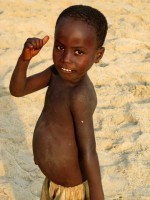
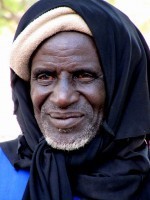
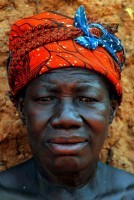
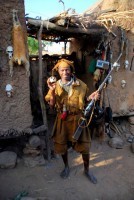
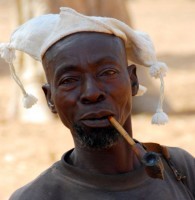
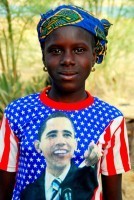
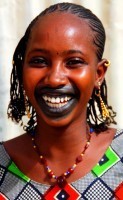
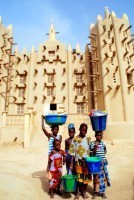
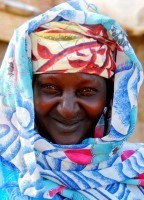
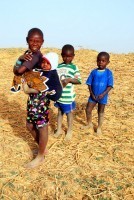


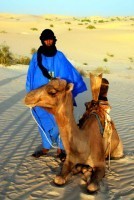
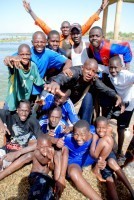
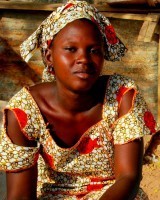
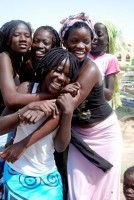

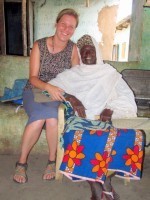
Blog post by Roderick Phillips, author of Weary Heart – a gut-wrenching tale of love and test tubes.
The post West Africa redux, Day 240 appeared first on Roderick Phillips.
March 24, 2014
Dakhla, Western Sahara, Day 239
After two months of intense tour-group travel, Christi and I are finally free. It is quite wonderful. Christi and I get quite ornery when we’re forced to travel with other people. We prefer to potter around at our own pace and do our own thing. Dragoman and Ahmed were useful to accomplish a lot in a relatively short space of time, but for the remaining 4 months of our Year of Wonder, Christi and I will be making lots of selfish decisions. And our first decision is to have a relaxing day (Sheldon, by contrast, has already boarded a bus to Agadir in Morocco proper). Let me explain that last comment. We are currently in the town of Dakhla, which is located in the disputed territory of Western Sahara. Until 1975, Western Sahara was a colony of Spain, but then the Spanish left (even repatriating the remains of Spanish citizens from the cemeteries) handing the reins of power to Morocco and Mauritania – without ever determining the wishes of the Sahrawi (the indigenous people of Western Sahara). The Sahrawis rebelled and under the guise of the Polisario Front they engaged in guerilla activities including bombing the Iron Ore train. Iron ore is much more valuable to Mauritania than Western Sahara and the Mauritanian government quickly gave up its claim. Morocco currently claims ownership of all Western Sahara (about 100,000 square miles), encouraging its citizens to settle in towns like Dakhla. The Polisario Front continues its political fight to regain control of Western Sahara, but there seems little will among the community of nations to allow the Sahwari to govern themselves.
Dakhla sits on a narrow peninsula, literally miles from anywhere. An airport connects it to Morocco proper and the town has developed from a traditional fishing port into a tourist resort for aquatic sports. Our room in the Tuareg Palace hotel (I think Ahmed would be horrified) is appealing on so many levels: sand does not constantly blow in our faces, neither are we targeted by vicious hordes of mosquitoes, and our beds (replete with soft mattresses and dazzling white sheets) do not move. I enjoyed a steaming hot shower last night and another this morning after sleeping 14 glorious hours. We also have great views out over the Bay of Dakhla and a pleasant promenade, but both the bay and the area in general is devoid of people. Aside from the Tuareg Palace there is little in the way of facilities (shops or restaurants) to encourage people to visit this part of town. And we seem to be the only guests in the Tuareg Palace.
Christi rather enjoys the local cuisine in each country we visit and she is particularly looking forward to sampling the exotic delights in Morocco. We therefore head off to the town center and poke around. There’s not much to see to be honest, although we do find some hole-in-the-wall authentic Moroccan restaurants and Christi goes for a lamb tajine with an order of dates and olives on the side. Christi has a broad taste palate, but for some reason she can’t abide olives. I give her credit for continuing to eat them in hopes that one day she will develop a taste for the damn things. But that day is not today. I ‘m a much fussier eater than Christi, I have to admit, and there is zero chance that I’ll be eating the olives or the dates. I’ve self-diagnosed myself as being texture-challenged and dried fruits of any kind immediately remind me of eating big juicy flies (which in turn makes me want to gag). Clearly I have deep psychological issues.
Dakhla is not high on our list of places to explore, so after securing onward passage to Laayoune, the largest town in Western Sahara, for tomorrow (if we are going to do nothing for a while, I’d rather do it in a town with some amenities and distractions) we return to the modest luxuries afforded to us by the Tuareg Palace. I bend the aerial on the TV and hit the screen a few times, but the TV stubbornly refuses to work, so I give up and begin reading our Lonely Planet guide to Morocco instead.
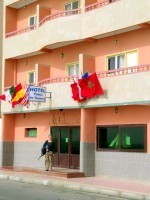
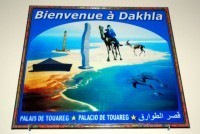
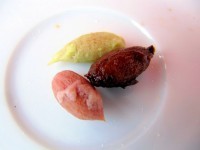
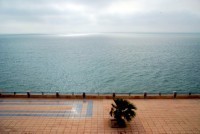
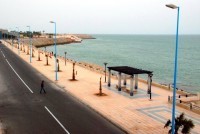
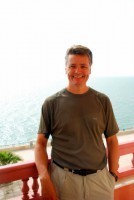
Blog post by Roderick Phillips, author of Weary Heart – a gut-wrenching tale of love and test tubes.
The post Dakhla, Western Sahara, Day 239 appeared first on Roderick Phillips.
March 23, 2014
Saharan sandstorm, Day 238
Traveling aboard the Iron Ore train at night is painful, literally. We have seat backs, but the upholstered seats themselves have long since been removed. Were it not for Sheldon’s blow-up mattress, we could add sore bums to the list of discomforts we endure. For a start the window does not close, so sand constantly swirls around the carriage, creating our own little private Saharan sandstorm. Also any time the door to the carriage opens (which happens frequently) a viciously cold cross-wind is formed and the sand swirls ever faster. Moreover, Christi, Sheldon, Ahmed, and I are squeezed into a space meant for three people, yet during the night our carriage compatriots Moulay and Mohamed insist upon insinuating their feet onto our limited bench space as they no doubt seek to find comfortable positions. I repulse the invasion repeatedly. Inevitably there are delays; the journey should have been 12 hours, but we do not arrive into the coastal town of Nouadhibou until 9:30 am (a total of 16 agonizing, uncomfortable, sleepless hours – that’s two nights in a row).
Ahmed lives in Nouadhibou and insists on arranging our onward travel to Dakhla in southern Morocco (also known as the disputed territory of Western Sahara). He invites us to his house to rest and eat while we wait for transport. The transformation in Ahmed the Finger as his children rush out to greet him is quite remarkable. Gone is the inscrutable Tuareg warrior, replaced by a family man hugging his children and enjoying their company. His home is surprisingly simple; guiding tourists is not as lucrative as I’d imagined. In the main living area mats covered the dirt floor and we sprawled out on cushions. Ahmed’s wife, Millmoun, is even more insistent that we stay and enjoy their hospitality and she rustles up a very tasty fish and chips in short order. The bathroom features another squat (god I hate that design) and offers a bucket shower, which the fastidious Sheldon and Christi soon enjoy. By this point I must be smelling quite rank, but I’m holding out for a hot shower, a sit-down toilet, a bed with clean white sheets. Such a decadent western fantasy.
Finding transport to Dakhla is problematic. It’s a long journey and no sept-place taxis in Nouadhibou will do the journey today. Actually that’s good news as far as I’m concerned, because my last experience in a sept-place taxi (from Dakar to The Gambia) was miserable. The best that Ahmed can do is a taxi to the Moroccan border; he thinks there will be onward transport from the Moroccan side. Needless to say, there are plenty of police checkpoints on the way to the border and Ahmed negotiates them all for us, even though our tour is technically over. Exiting Mauritania is straight forward, but then we enter 3 km of no man’s land. Some say this land is under the rule of the Polisario, the Western Sahara independence movement; one thing is for sure the road is an not maintained crumbling track, but warning signs abound not to stray from the main route because the area is extensively mined. That suddenly makes the journey a little more interesting as does the sandstorm that appears from nowhere. The taxi can only go so far and Sheldon with his two backpacks slung across his front and back not to mention a daypack (this guy does not travel light) and Christi and I trudge the remaining distance, heads bowed to avoid the worst of the billowing sand.
Moroccan immigration is a nightmare. They are shocked to see three pedestrians arriving from Mauritania in the middle of a sandstorm no less. The border is not closed exactly, but the ongoing geopolitical unrest means that tourists are a rare breed hereabouts. Our paperwork is studied extensively; our bags receive endless attention. Between immigration, customs, the police, the army and numerous other shady characters from Moroccan officialdom we are stopped six times in the space of 100 yards, although quite what they are expecting to find is beyond me. Once we finally and officially make it into Morocco we are still some 200 miles south of the first recognizable town, Dakhla. Our only transport option for Dahkla is a Mercedes grand-taxi, which sounds much more impressive than the reality. Four paying passengers, including Christi, Sheldon and me contort ourselves into the back of this beat-up Mercedes, touching hip to hip and shoulder to shoulder, while three (including the driver) sit up front. The journey is four excruciating hours with nothing to look at apart from flat, featureless rubbish-strewn desert. It is dark when we reach the bright lights and tall buildings of the man-made Dakhla oasis - an outpost of civilization. And to us civilization is a bed with clean sheets, a shower with hot water, and a TV. The TV does not actually work, but two out of three ain’t bad. Dakhla also sees the parting of the ways for Sheldon and ourselves. Masochist that he is, Sheldon is determined to push on into Morocco after only one night in Dakhla. We share a last supper together and then say goodbye to the crazy, loveable bastard.

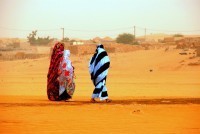
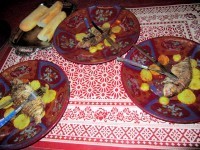
Blog post by Roderick Phillips, author of Weary Heart – a gut-wrenching tale of love and test tubes
The post Saharan sandstorm, Day 238 appeared first on Roderick Phillips.
March 22, 2014
Aicha monolith and the Iron Ore train, Day 237
Not surprisingly neither Christi nor I slept particularly well last night as sand constantly blew into our faces. My only escape was to bury myself ever deeper into my sleeping bag. Sheldon, on the other hand, emerges from his tent quite refreshed, the bastard. Christi and I use wet wipes to scour some of the Sahara off our bodies before packing our bags. We are given 1 hour to explore the monolith, although no one has the energy or enthusiasm to scramble to the top. In essence Ben Amira is a gigantic basalt rock, surrounded by sand dunes and within earshot of the iron-ore train. It is easy to spot the effects of weathering as chunks of rock have broken free from the dome-shaped monolith. Other smaller monoliths dot the area, including the Aicha, the former wife of Ben Amira. So the local story goes, Ben Amira and Aicha used to be married but are now divorced and the large boulders located between the two are tears of mourning. At the turn of the millennium, twenty artists from around the world gathered at Aicha to create unique sculptures that express man’s relationship with woman. The artwork represents 21st century petroglyphs in an open-air museum. One wonders what future generations will make of the images. It’s a wonderful experience to explore with absolutely no one else around (aside from a few camels).
With time running out we leave the monoliths for one last desert safari to the train station at Choum. And a more depressing, disgusting group of shacks you could not wish to see. Quite why anyone, no matter how desperate they are, should wish to live here is inexplicable. There are zero tourist amenities and I think Ahmed persuades a random family to take us into their house and feed us for a few hours. Christi and Sheldon are pleased to find the house has a very basic bucket shower and they jump at the chance to get clean. I am more comfortable with dirt apparently and don’t feel the need to bathe, although I would pay a king’s ransom for a sit-down western toilet. Alas that option is not available. The toilet is outside – anywhere you fancy. The terrain here is flat and featureless desert apart from an odious rubbish dump and a heap of sand which is used to make bricks. It is my worst nightmare as I plod to the dump to make my own deposit. Choum does not possess a ticket office, a platform, or any sign (other than the train tracks) that a train might ever stop here. While Sheldon, Christi, and I nibble on carrot stew and seek solace in the shade, Ahmed is attempting to get us tickets. There is little information to be had other that the train is always full leaving Zouerat (5 hours further north). Zouerat is where the iron ore is mined and then it has to be transported out to the coastal town of Nouadhibou. The main business of this train is transporting iron ore; passenger freight takes very low priority. One carriage is a sleeper car; another has seating. People can, although it is not encouraged, travel on one of the 220 cars carrying the iron-ore. Be prepared to fry during the day and freeze at night, while sand storms and the dust from the iron ore continually attacks every orifice. The train isn’t much of an option, but it is the fastest way out of Mauritania.
We gather at the tracks near a sign saying passenger stop. Miraculously, an agent of Mauritania Railway appears and sells us 4 tickets at US$10 each, although we only have access to wooden seats not the sleeper carriage. The iron ore train arrives at 5:15 pm, the passenger carriages, which are at the rear, several minutes later. The scramble is intense, and it’s a steep climb into the carriage. Ahmed leads the way and we follow thrusting bags up and into unknown hands. All compartments within the carriage are occupied – with belongings if not people. We gate-crash one of these much to the annoyance of the locals and refuse to move until the ‘conductor’ finds space for us in another compartment. We are eventually crammed into a space meant to hold only three people and the floor in front of us is filled with boxes and coolers so there is nowhere to put our feet. Furthermore, I think the conductor actually ousted two young seemingly gay men so that we could have their seats.
Having placed our bags on the overhead racks and eked out space for our bodies and legs the questions begin. We are instant celebrities and in addition to the three other people in our compartment a crowd of curious onlookers stare at us from the corridor – and I do mean stare. It’s a little disconcerting. One of the fellow passengers in our compartment, a large black avuncular fisherman called Moulay, is particularly inquisitive. He wants our names, ages, occupations, and number of children we each have. Sheldon takes on the role of translator again. The fact that Christi and I have no children after 10 years of ‘marriage’ is met with looks of utter consternation. Moulay offers to arrange a second, younger, and more fertile wife for me. I agree enthusiastically, of course. One of the three passengers in our compartment is a woman traveling alone. Her name is Ayshe and she is returning to Nouadhibou after visiting her husband who works in the mines at Zouerat. I ask whether independent travel for unaccompanied women is acceptable in Mauritania. She says no problem; Moulay disagrees and scowls. Our final companion is Mohamed who appears to make a living by providing food for the whole carriage. I watch fascinated as he cuts up vegetables and camel meat and tosses it all into a pot sitting on a propane stove situated between his legs and mine. I then watch warily as he lights the gas. The train jerks and pulls us into another long and uncomfortable night, only this time conflagration is a real possibility.
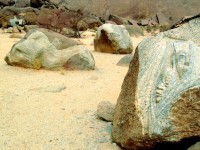

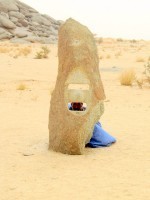
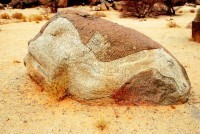
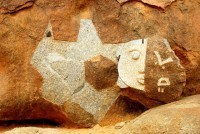
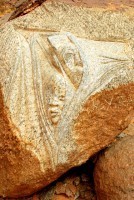
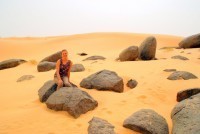
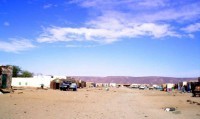

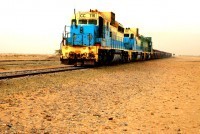
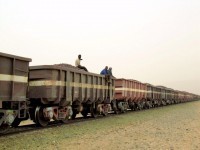
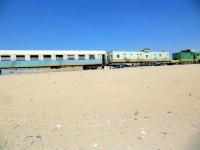
Blog post by Roderick Phillips, author of Weary Heart – a gut-wrenching tale of love and test tubes
The post Aicha monolith and the Iron Ore train, Day 237 appeared first on Roderick Phillips.
March 21, 2014
Ben Amira, Mauritania, Day 236
Sheldon arrives at Tanouchert oasis mid-morning looking mangier than ever. He says he had fun, walking in the mornings and riding his camel after lunch. He spends all of 15 minutes exploring Tanouchert and suggests we move on to our next destination, Ouadane, yet another dilapidated Saharan town further to the east. It’s at this point that Ahmed realizes that our current itinerary is a day longer than we have paid for. He wags his finger menacingly. Either we pay more or do less. Christi is dead set against spending more time or more money so we eliminate Ouadane in favor of Ben Amira (the third largest free-standing monolith in the world after Ayers rock and Mount Augustus, both of which are in Australia). Unlike Ouadane, Ben Amira is in the same general direction as Choum, our final destination. The only reason to go to Choum, incidentally, is to catch the famous Iron Ore train out to the coast at Nouadhibou. And while Sheldon, Christi, Ahmed and I let the train take the strain, Mahmoud will drive the Toyota Hilux back to the car rental agency in Nouakchott.
To save some time and avoid the endless police checkpoints, Ahmed decides to strike out across the desert. The locals in Tanouchert think Ahmed is crazy to go off-piste and I tend to agree with them. Mahmoud heads into the desert, while Ahmed stares intently behind us and then ahead of us somehow calculating the mental path he wants to follow. I just hope his magnetoception is switched on. The route is not promising. We encounter lots of bumps, quick turns, and unexpected twists – it’s like being in a bumper car at an amusement park – but amazingly we arrive in Atar in time for a quick lunch. After eating and stocking up on a few supplies we continue. Choum is 80 km due north of Atar and Ben Amira is a further 80 km to the west of Choum.
We leave Atar on paved roads, which gives me an opportunity to mention another quirk of Ahmed’s. He is continually brewing tea on the floor of the front seat of the Toyota – as we’re driving along. He actually has a small propane burner on which he puts a tiny tea kettle. Once the kettle is boiled he makes sweet, black tea which he pours into small glass tumblers and offers to us. Ahmed never spills a drop either. You have to drink by the way; you don’t refuse the hospitality of a Tuareg. He only does this on paved roads, I hasten to add, because our off-road driving is spectacularly rough. We are literally creating our own trail across the Sahara. Of course, the Tuareg have been doing this for thousands of years, and no doubt Ahmed would be able to save himself should anything go truly wrong, but Christi, Sheldon, and me would be screwed. Fingers crossed Ahmed knows what he is doing. Interestingly the scenery here is different. No longer do we stare out over a sand sea, instead we dodging between and around large black basalt formations. Photography is not an option as the vehicle pitches, bumps, and zig zags, which is jolly uncomfortable.
Later that afternoon, Sheldon confirms that Ahmed has decided to bypass Choum altogether now and heading straight for Ben Amira. The short cut will ensure we reach Ben Amira tonight and will allow us to camp out under the stars. This is all very well if, like Sheldon, you’re carrying your our tent, mattress, and mosquito net. Christi and I now have nothing to protect us from a cold night in the Sahara Desert. Despite the time-crunch, Ahmed never passes up the opportunity to stop and drink tea with local nomadic groups – mostly camel herders. Perhaps he’s asking for directions! To give you a sense of the remoteness in which we find ourselves we eventually hit the train tracks of the famed Iron Ore train. There’s not a trace of humanity anywhere on the horizon, but as long as we remain near the tracks we’ll be fine. We follow the tracks west for several more miles and come across the tiny train station of Ben Amira. There are no camping supplies available to rent or buy, so an uncomfortable night lies ahead. A few miles north of the train station is the giant basalt monolith of Ben Amira itself . We arrive and set up camp under the shadow of Ben Amira 8.5 hours after leaving Tanouchert as the sun sets over the Sahara. In the rapidly fading daylight Christi and I lay out our sleeping bags on a tarpaulin base and then help prepare dinner: camel stew. Using a single pot, hastily bought by Ahmed in Atar (together with some cutlery) plus charcoal that Sheldon acquired, we add carrots, tomatoes, garlic, onions, and the camel, which cooks on the famous propane burner for an hour. Then we add rice and let that cook until the rice has absorbed all the water from the stew. The resulting meal is surprisingly good; sleeping on corrugated ridges of sand in the chilly Sahara with dust blowing in our faces all night much less so. But what the hell, we did it.
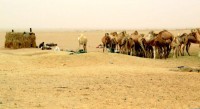

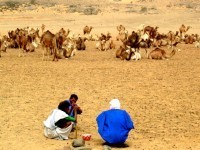
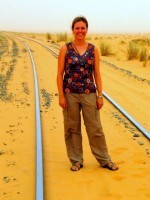
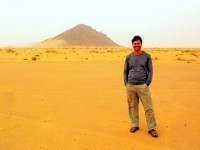
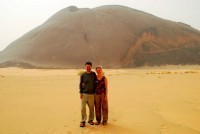

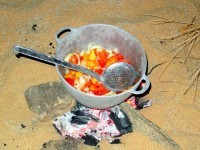
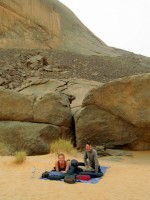
Blog post by Roderick Phillips, author of Weary Heart – a gut-wrenching tale of love and test tubes.
The post Ben Amira, Mauritania, Day 236 appeared first on Roderick Phillips.
March 20, 2014
Tanouchert Oasis, Day 235
While Sheldon boldy goes where no nerd has gone before, Christi and I elect to surf the dunes in the Toyota Hilux with Ahmed and Mahmoud. We will all meet tomorrow at the remote (how much more remote can we get?) oasis of Tanouchert. The good news from my perspective is that the one ciprofloxicin tablet I have taken to date has brought immediate benefit. My stomach is no longer churning, while my bowels are solidifying nicely. And all of this is just as well since Mahmoud has chosen to approach our Saharan safari as a part of the Paris-Dakar rally. Thus my stomach finds another reason to churn; good old-fashioned travel sickness. The absence of Sheldon also has the added benefit of giving Christi and I more room in which to bounce around as Mahmoud crests another dune and plummets down the other side. During the whole 40 km journey to Tanourchert we see one lone camel herder, but plenty of camels and goats. There are scribbles of dry brush plus a few surprisingly large thorn trees en route, but mostly its soaring sand dunes. Remember that scene in the movie The Perfect Storm – yeah, it’s a bit like that. There’s definitely a feeling of solitude and vast emptiness. Without Ahmed we would die in the Sahara, which gives the whole experience a frisson of excitement.
I think it’s time to explain the correlation between Ahmed and his finger. Quite how he knows where to go is unclear, but I think he uses the same magnetoception as birds to perceive direction. This sixth sense if you will is based on the ability of the individual to use the earth’s magnetic filed to determine where they are and hence where they are going. Perhaps its a Tuareg thing (they are a nomadic people). If so, Mahmoud does not have this sixth sense and he merely plows through one sand dune after another. Occasionally, Ahmed raise the index finger of his left hand and moves it an infinitesimal amount to the left or right and Mahmoud alters direction accordingly. Hence Ahmed the Finger. The Finger brings us safely into Tanouchert 2-hours after leaving Chinguetti (it will take Sheldon 2 days. So who’s the brainiac now?).
We check-in at a mirage called Chez Chigaly, which in my mind at least has sit-down toilets and a hot shower. Chez Chigaly has neither. Instead we enter a scene from the Arabian Nights: a large communal tent at one end of which is the owner of Chez Chigaly and his family. Ahmed and the owner go into a huddle and after a muted conversation hot black tea is brewed and we are invited to sit on a collection of cushions and join in. While we drink our own tent is prepared. It is filled with colorful carpet, pillows, and mattresses. We add our own finishing touch: a mosquito net.
Later, when the temperature have cooled a little, we explore, well, the middle of nowhere. There is no obvious water source; mostly the water appears to be pumped up from below ground. We come upon one such water hole near our camp called The Camel’s Head. Apparently camels come here to socialize and down a few pints. The human inhabitants of Tanouchert are no less interesting: they flatten empty oil drums to use as sidings on their homes (which I suppose makes them more permamnet than those made of palm leaves); they go to the bother of fencing off their properties (from who?) and they have vegetable gardens. It’s an odd sight to see carrots and lettuce growing in the middle of the Sahara Desert. Further out is a grove of palm trees and beyond that the sand sea. If I was to keep walking without adequate water and supplies I would be dead in a day, two at the most. Instead I return to my tent, collapse into the cushions, drink copious quantities of water and day-dream about ice-cold sodas and air-conditioning.

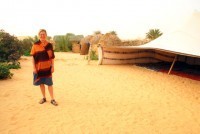

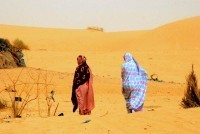

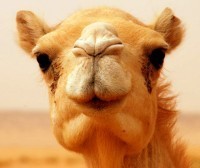
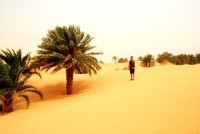

Blog post by Roderick Phillips, author of Weary Heart – a gut-wrenching tale of love and test tubes.
The post Tanouchert Oasis, Day 235 appeared first on Roderick Phillips.
March 19, 2014
The Friday mosque of Chinguetti, Day 234
Christi and I are left to our own devices today – no Sheldon or Ahmed telling us what to do. Our plan is three-fold. Move to better accommodation; explore more of the Old Town, including the Friday mosque of Chinguetti; and take a peek at the Sahara Desert, which is, well, everywhere. But all that is for later. Sheldon leant us his mosquito net last night, which at least kept the mosquitoes from violating my body, although I could still hear them plotting my demise. Sheldon gets up early (and noisily) to begin his walking / camel safari, which has been abbreviated to two night because of my unfortunate mishap in Atar. By the way, the Lonely Planet guidebooks to Africa take great joy in describing all the health calamities that might befall the unsuspecting traveler. And if you weren’t feeling sick before you began reading, it’s pretty easy to convince yourself that death is imminent as you suddenly develop a whole bunch of lethal symptoms. I made the mistake of browsing through the information this morning, and while it confirmed that my seizure was the result of a rather extreme case of dehydration, I do also have the symptoms for Dengue Fever, Leishmaniasis, and Sleeping Sickness so the chances of me living until lunch time appear pretty remote. As I lie on my mattress absorbing this gruesome information, my stomach begins it’s daily grumble. I grin and bear it until my intestines feel they are about to explode and then I plod despondently to the squat.
I think my continued ill-health is an affront to pharmacist Christi who makes it her mission to cure me today. She begins with a medical history: no fever, no bloody stools, and no severe stomach cramps (apparently only women ever truly endure severe stomach cramps), so my diagnosis is a mild case of diarrhea. Are you kidding me? Christi reluctantly admits that the diarrhea is persistent (more than a week now) and equally reluctantly suggests immodium, more rehydrating salt water (which is supposed to be restoring my electrolyte balance, but which I think is driving me mad) and a course of antibiotics (the flavor the month is ciprofloxicin twice daily for 5 days).
The manager of our hotel, Cheikh, is disappointed that we are planning to leave and tries to arrange another program for us (a program being any mechanism possible to extract more money from us). We decline and he watches unhappily as his only source of income disappears in a minor Saharan sandstorm for Le Maure Bleu, which comes highly recommended by the Lonely Planet. But it’s a disaster. La Maure Bleu is four times as expensive as the Auberge La Rose des Sables for only a little more comfort - and most of that comes in the form of a western sit-down toilet. I do shed a tear as I say goodbye to the toilet, but then it’s back into the welcoming arms of Cheikh Ould Amar, who promises to find a fan to make our stay more comfortable.
Later in the day we escape the watchful gaze of Ahmed and Cheikh to explore Old Town on our own. We cross the wadi again and head up the sandy streets to the 13th century Friday mosque of Chinguetti. At its center is a square, stone minaret capped with five ostrich egg finials dominates the skyline. Supposedly it is the second oldest minaret in continuous use anywhere in the Muslim world. The Friday mosque of Chinguetti is popularly considered the national emblem of Mauritania, but not being Moslem we do not get to poke around inside. The fact that we stand admiring the building for two minutes appears to be a signal for the local hawkers to harass us so we move on to the Sahara Desert. Clearly Ahmed is concerned that Christi and I will wander off and die a horrible death in the desert because he and Mahmoud follow us at a discreet distance. The desert around Chinguetti is archetypal Saharan scenery: endless rolling sand dunes – the so-called sand sea (or erg in Arabic), which goes on for miles. And after wandering up and down a few dunes (which is hard work in my delicate condition), we gratefully accept a ride back to the hotel where Cheikh has prepared couscous and some seriously chewy camel for dinner. We eat for longer than we had anticipated and then retire to our room, which now boasts a fan and a mosquito net. Not only can the evil little bastards not bite me now, but the noise of the fan drowns out the sound of their frustration. Sheer bliss.

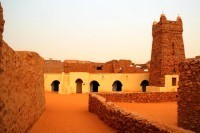

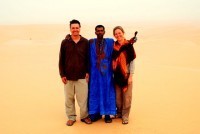
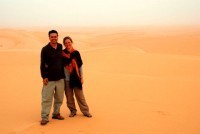
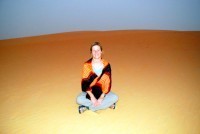
Blog post by Roderick Phillips, author of Weary Heart, a gut-wrenching tale of love and test tubes.
The post The Friday mosque of Chinguetti, Day 234 appeared first on Roderick Phillips.
March 18, 2014
Old Town Chinguetti, Mauritania, Day 233
One thing you can be sure about when you travel, and especially if like Christi and I you go for long vacations, you always meet someone who is doing a longer or more spectacular trip. It’s not that I’m jealous so much as envious. Are these people even less career-driven than me or do they have unlimited wealth or can they survive on a tin of beans and a stick of celery each day while finding the prospect of sleeping under a convenient bush or rock simply the most wonderful thing in the world (I could never master that level of self-deprivation). I mention this because in my half-crazed state Christi, Sheldon, and I met two such people last night at dinner. This couple is dedicating 5 years to travel in a converted Mercedes-Benz truck. This thing looks like a tank and makes the Dragoman truck look luxurious by comparison. Still they carry enough supplies for themselves and their two dogs for 2 months and can wander pretty much wherever they want – road or no road. And for a really dedicated traveler check out this blog. This guy has been traveling since 1988; I feel so pathetic by comparison. I do, however, feel much better than yesterday and the chances of me living are pretty good. They would be a lot better if Christi did not insist I continue to drink the vile concoctions she procures from her portable pharmacy. Sheldon is of course itching to be on his way to Chinguetti, although a decision is made to report my ‘condition’ to the local police station who agree to let me continue.
The road to Chinguetti is initially paved and easy to negotiate, but this quickly deteriorates into a rutted track as we climb up through another desert escarpment. The one thing we see little of is people; literally only a handful during our whole drive to Chinguetti. Camels on the other hand are all over the place. It’s the desert version of New Zealand (There are 3 million people in New Zealand and 60 million sheep. The population of Mauritania is 3.5 million – with about ten times as many camels). We reach Chinguetti surprisingly quickly and Sheldon has already decided on a hotel – the Auberge La Rose des Sables – mostly so he can arrange his camel safari with the affable Cheikh Ould Amar. Sadly for Sheldon the camels are grazing some 20 miles away and so the earliest he will be able to depart is tomorrow. Reluctantly, therefore, he accompanies Christi and I on a tour of this desert town.
Chinguetti is a lot like Timbuktu: remote dilapidated, and surviving on former glories. But again its history is what makes the town a fascinating place to visit. Historically, it was important town on the edge of the Sahara where camel caravans passed through laden with salt and other goods. It was at one point the capital city of the Moors and remains the 7th holiest city in Islam after Mecca, Medina, Jerusalem, Cairo – and a few others that are hotly disputed by the followers of Islam. In its heyday Chinguetti was a major site of Islamic study with numerous mosques and koranic schools, but the town has fallen on hard times. Chinguetti suffers from rampant desertification – the dunes are gradually reclaiming this ancient town. On our tour we pass by the former Fort Saganne hotel, which was a location in the 1984 film Fort Saganne starring Gerard Depardieu. The movie describes in part the privations experienced by the French Foreign Legion in these parts – and we paid to come here! Next we cross the wadi (dry river bed) that separates the New town (where we are staying) from the ksar (fortified Old Town). At this time of year the wadi makes a rather excellent football pitch. Old Town Chinguetti is a maze of narrow streets with houses decaying into rubble. We stop at one of the many libraries that still dot the town. The library houses exquisite manuscripts dating back to the late Middle Ages.
Force myself to eat macaroni and chicken for dinner – and then force myself to walk, not run, to the hotel squat. It is at least clean, if an aesthetically unappealing place to linger.
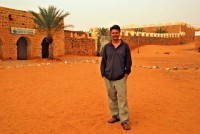
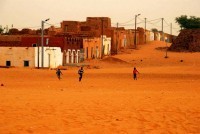
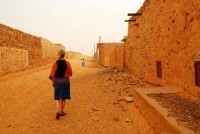
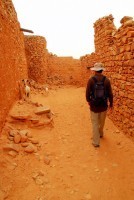
Blog post by Roderick Phillips, author of Weary Heart – a gut-wrenching tale of love and test tubes.
The post Old Town Chinguetti, Mauritania, Day 233 appeared first on Roderick Phillips.
March 17, 2014
Terjit oasis, Mauritania, Day 232
Undoubtedly the worst travel day of my entire life. Read on to learn the gory details. The rooms and the gardens at the Auberge de Caravans are actually quite pleasant, but I had a miserable night there. I’m either being bitten by mosquitoes (because the net which is draped from a hook in the ceiling does not completely encircle my mattress, thus making me a tasty target for the damned bugs) or I was plodding through the gardens repeatedly during the night on ever more desperate visits to the heinous squat. Needless to say I did not get up at dawn (unlike that man of perpetual motion, Sheldon Cooper) and neither do I have any noticeable enthusiasm (again unlike Sheldon). Sheldon hopes to organize a multi-day desert safari in Chinguetti (a medieval trading centre located several hours further north) and is keen to be on his way. I thought our itinerary allowed for a whole day relaxing at the nearby Terjit oasis (which is about all I can manage right now) but Sheldon and Ahmed have been talking and in order for Sheldon to complete his desert safari and the other elements of the itinerary in the time allotted we can only make a brief visit to the oasis. I’m not happy about this change to our plan, but equally, I don’t feel well enough to argue, so after slowly packing our bags, Christi and I join Sheldon, Ahmed, and Mahmoud for the short ride to the palmerie. Incidentally, unlike Sheldon, Christi and I have no intention of slogging through the heat of the Saharan desert for several days so we will follow a slightly more sensible itinerary while he fries.
The scenery around Terjit, which we missed yesterday due to our night-time arrival, is starkly beautiful. Plateaus and ridges rise up out of the desert, a little reminiscent of the Bandiagara escarpment. And in the midst of this arid wasteland is the palmerie of Terjit. A gently trickling stream, soaring palm trees shaded by an overhanging escarpment and some pools to splash around in to cool off. The Auberge Oasis de Terjit seems to own the rights to the place and we are charged a UM1500 (US$6) entrance fee (the currency in Mauritania is the Ouguiya and good luck pronouncing that by the way. It’s something like oo-gee-ya). The entrance fee actually pays for a tent for the night – or in our case a couple of hours. I explore briefly and toy with the idea of relaxing in the pools, but my stomach is proving so burdensome that I retire to our tent and try not to move. Ahmed is becoming concerned about me and frequently inquires about my condition. I keep a British stiff upper lip and smile weakly; his enigmatic frown deepens.
By mid-afternoon we begin the 3-hour ride to Chinguetti via Atar, the regional capital. We stop in Atar for Sheldon to buy supplies ahead of his camel safari and for Ahmed to photocopy our passports. Ahmed says (translation courtesy of Sheldon) that providing copies of our passport details to themyriad police checkpoints should speed up our progress. Christi pokes around the shops as well, while I stagger out of the car in hopes of finding somewhere more comfortable to sit for a while. I’ve only taken a few steps when I become light-headed and have to stop. The sun is beating down and Christi insists I move into the shade of a nearby internet cafe.
I sit; I feel nauseous; and then…nothing. Christi says I experienced some sort of seizure or convulsion. My arms went rigid, I began shaking, and my eyes rolled back into my head. I became unresponsive and ultimately lost consciousness. She said she was very scared. I’m not sure how long I was unconscious, but I eventually begin to hear Christi’s voice. It’s vague and distant as if she’s calling to me from a different room. I don’t hear everything she says; her voice is hazy and fuzzy. I open my eyes (I don’t remember closing them). Even in the internet cafe the light seems very bright. I can’t focus immediately, but I do hear Christi shouting my name. She starts to fire questions at me: who am I; where am I; how old am I. Her questions are annoying. I respond slowly, irritated by the effort required. As the mental fog clears and I become more cognizant of my surrounding, Christi bursts into tears. There’s talk of going to a hospital, but I refuse. Instead, I’m taken to the nearby Auberge Bab Sahara and installed in an air-conditioned room (actually a tikit or stone hut). Here Christi delves into a bag of pharmaceutical tricks and makes me drink the most disgusting rehydration mixture. It’s like drinking sea water. I nibble on Pringle chips and slowly recover enough to join our group for dinner. Mine is a blissfully boring white rice dish, but at least I’m still alive to eat it. And despite what you may be thinking I did not collapse on purpose to ruin Sheldon’s camel safari.
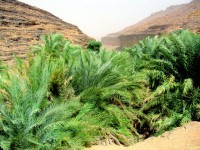
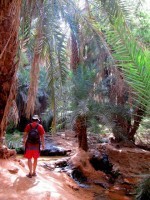
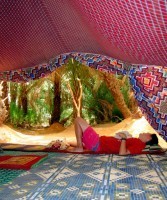
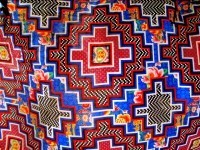
Blog post by Roderick Phillips, author of Weary Heart – a gut-wrenching tale of love and test-tubes.
The post Terjit oasis, Mauritania, Day 232 appeared first on Roderick Phillips.
March 16, 2014
Ahmed the Finger, Nouakchott, Day 231
We’ve had occasional e-mail contact with Sheldon Cooper since we went our separate ways in Dakar, so hopefully he and Ahmed the Finger will find their way to our hotel at some point today. Other than another visit to the cheap and cheerful schwarma restaurant across the road we don’t stray too far from our hotel, preferring to sit in the shady garden and read and get the diaries up to date. Having noted yesterday that the orange drink at the schwarma restaurant looked lethal, I stupidly drank the noxious fluid today and my intestines confirm my suspicions. They rebel violently and persistently, which is not the best preparation for exploring a country as wild as Mauritania.
Sheldon Cooper (sporting a big, fat cheesy grin) and Ahmed the Finger (looking altogether more serious. In my limited experience the Tuareg never smile) arrive in the early afternoon, which is a relief. Sheldon Cooper is a man of perpetual motion and says he wants to visit the fish market and leave Nouakchott today for the oasis town of Terjit in the Adrar region in northern Mauritania. This is the most touristic part of Mauritania (which isn’t saying much), and also well away from the outstretched fingers of Al-Qaeda.
After a brief reprise of yesterday’s visit to the fish market, we turn to the thorny issue of the detailed itinerary and more importantly the cost. There is a lot of head shaking and rueful smiles as Sheldon who (by virtue of his near-perfect French) outlines our (mostly his, in fact) desired itinerary with the French and Tuareg-speaking Ahmed. There are some weighty issues to be debated. First, Ahmed has hired a Toyota Hilus 4WD with interior roll bar, which is a very uncomfortable fit for three people (Ahmed the Finger only guides and does not drive so he will be sitting in the front with Mahmoud, our driver). Apparently it is possible to organize a Toyota Land cruiser, but it will take time and an additional 300 euros – so no basically. Shrewd these Tuareg. Ahmed also appears disinclined to feed and accommodate us, allowing a total of only 50 euros (US$70) per person for the entire 7 days of the trip.
We renegotiate the deal: previously it was a total of 1150 euros for 7 days; now we all agree to 1000 euros (US$1400) for an 8-day trip and Sheldon, Christi, and I will take care of our own food and accommodation. We also get the itinerary we want. This begins with the long drive out to the Adrar region. We don’t leave Nouakchott till 5 pm. Nouakchott is a low-slung city, dominated by small box-like buildings that lies on an equally flat landscape. Consequently there is nothing to stop the Sahara invading the streets, which it does whenever the wind blows. And even in the suburbs of the capital there are tents erected and camels grazing beside them. It’s all a bit surreal. Our progress to Terjit is slow because there are police checkpoints every 50 km and the officers insist on copying down all the details in our passports (even though I’m sure none of them actually understand English). We reach Terjit at 11.30 pm and it takes some persistent banging on the corrugated iron gates of the Auberge de Caravans before we are allowed in. Christi and I collapse into bed near midnight. It is clear that traveling with Sheldon Cooper is going to be exhausting.
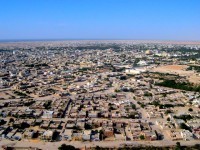
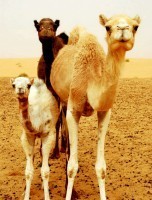
Blog post by Roderick Phillips, author of Weary Heart – a gut-wrenching tale of love and test tubes.
The post Ahmed the Finger, Nouakchott, Day 231 appeared first on Roderick Phillips.

